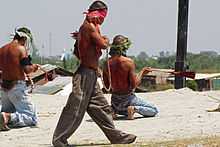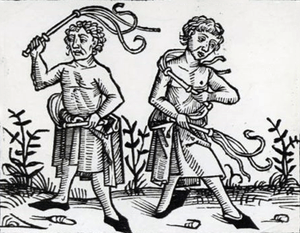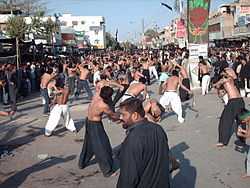Self-flagellation

Self-flagellation is the act of hitting oneself with a whip as part of a religious ritual.
Roman Catholicism

The Flagellation refers in a Christian context to the Flagellation of Christ, an episode in the Passion of Christ prior to Jesus' crucifixion. The practice of mortification of the flesh for religious purposes was utilized by some Christians throughout most of Christian history, especially in Catholic monasteries and convents.
In the 13th century, a group of Roman Catholics, known as the Flagellants, took this practice to its extreme ends. The Flagellants were later condemned by the Roman Catholic Church as a cult in the 14th century because the established church had no other control over the practice than excommunication. Self-flagellation remains common in the Philippines, Mexico, and one convent in Peru.
Some members of strict monastic orders, and some members of the Catholic lay organization Opus Dei, practice mild self-flagellation using an instrument called a "discipline", a cattail whip usually made of knotted cords, which is flung over the shoulders repeatedly during private prayer.[1] Pope John Paul II took the discipline regularly.[2]
St. Therese of Lisieux, a Carmelite nun of late 19th-century France who has now been declared a Doctor of the Church, is an influential example of a Catholic Saint who questioned prevailing attitudes toward physical penance. Her view was that loving acceptance of the many sufferings of daily life was pleasing to God, and fostered loving relationships with other people, more than taking upon oneself extraneous sufferings through instruments of penance. However as a Carmelite nun, she practiced voluntary corporal mortification.
Because practices such as starvation, sleep denial and flagellation are known to induce altered states, flagellation may be used by religious ecstatics and mystics as part of ritualistic practices or ceremonies to achieve unusual states of mind.
Islam
Shi'a communities worldwide march in massive parades every year on the Day of Ashura to commemorate the Battle of Karbala and the martyrdom of Imam Hussein, while flogging themselves on the chest. Though it is uncommon, some Shi'ite communities flog themselves on the back with chains and sharp objects such as knives. Some of these practices include zanjeer zani (self-flogging) and tatbir. This happens in many countries around the world including India, Pakistan, Iraq, Lebanon, United States[3] and Australia. In Iran use of knives and sharp blades for flagellation is uncommon but chains are used. These practices happen in most Shia countries of the world, though in Saudi Arabia they are strictly forbidden in every form.
References
- ↑ "Opus Dei and corporal mortification". Opus Dei Information Office. 2012.
- ↑ Barron, Fr. Robert. "Taking the Discipline".
- ↑ "Video of self-flaggelation with knives and chains at mosque in Atlanta, Georgia, USA". 2014.
